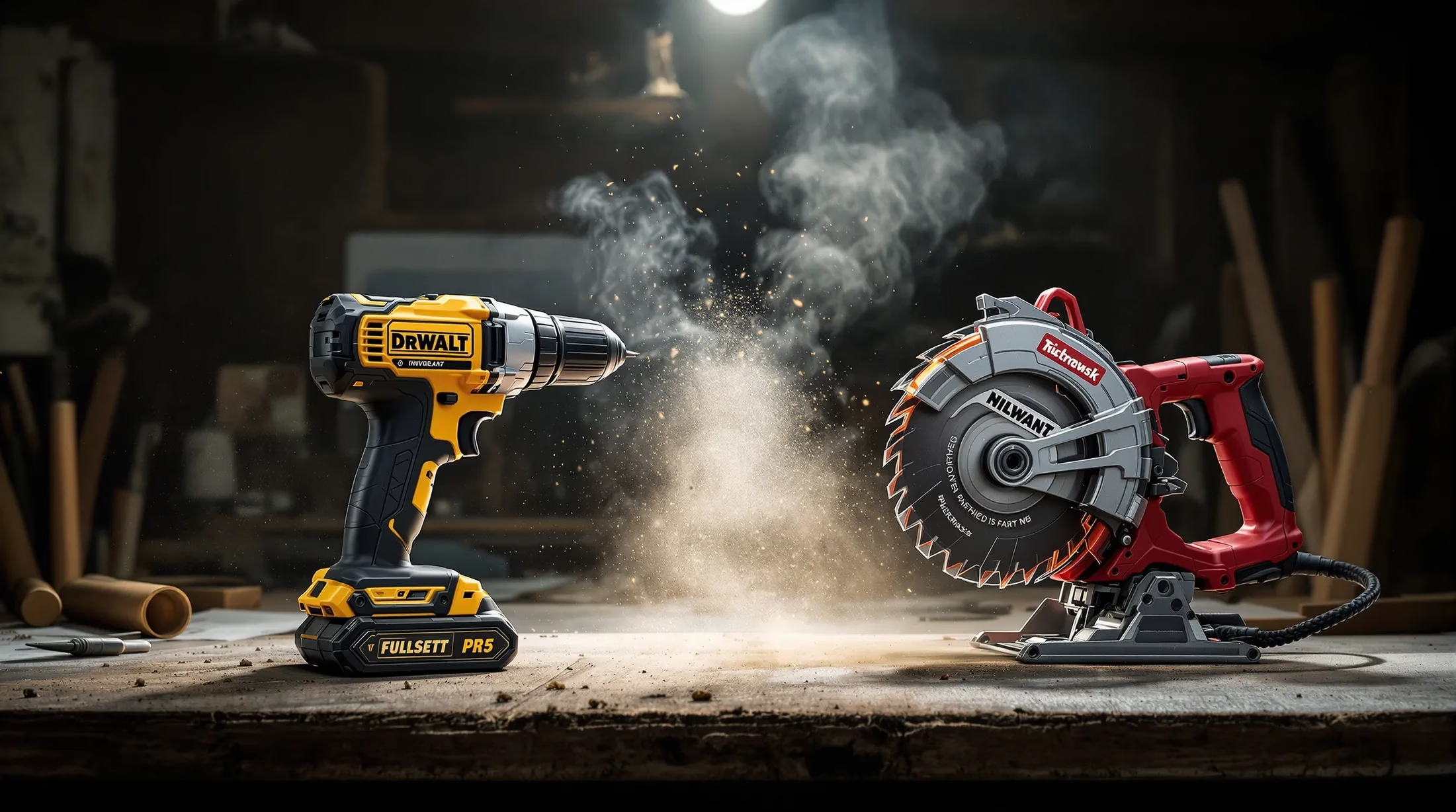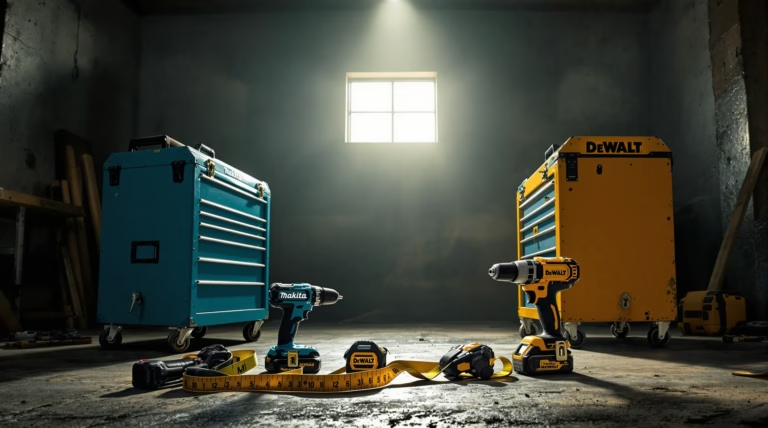Dewalt vs Milwaukee: Which Tool Brand Reigns Supreme?
Looking to invest in professional power tools but caught between Dewalt and Milwaukee? This comprehensive comparison breaks down everything you need to know about these industry titans, from their rich histories to cutting-edge innovations, helping you make an informed decision for your specific needs.
In the world of premium power tools, Dewalt and Milwaukee represent excellence in craftsmanship and innovation. Each brand commands a loyal following, backed by decades of proven performance across diverse projects and working conditions.
The comparison between these powerhouses encompasses multiple crucial factors:
- Manufacturing philosophies and product quality
- Technological innovations and battery systems
- Performance metrics and reliability
- Warranty coverage and customer support
- Price points and value proposition
While Milwaukee emphasizes cutting-edge technology and maximum power output, Dewalt focuses on delivering consistent performance and value. For professionals and DIY enthusiasts alike, the choice often depends on specific needs, budget constraints, and long-term investment strategy.
Brand Overview: Dewalt and Milwaukee
Both manufacturers have established themselves as industry leaders, targeting professional contractors and serious DIY enthusiasts. While Dewalt previously dominated brand recognition, Milwaukee has significantly closed this gap through aggressive innovation and product development.
History and Background of Dewalt
Founded in 1924 by Raymond Dewalt, the company’s journey began with the invention of the radial arm saw. After Black & Decker’s acquisition in 1960 and subsequent merger with Stanley in 2010, Dewalt has continued to innovate, particularly with their groundbreaking 20V Max system (2011) and FlexVolt platform (2016).
History and Background of Milwaukee
Milwaukee’s story also began in 1924 with the revolutionary Hole-Shooter drill. Under Techtronic Industries’ ownership since 2005, the company has become synonymous with professional-grade tools and continuous innovation, particularly in their M18 battery platform and Fuel brushless technology.
Product Range and Innovation
Both brands offer extensive product catalogs with distinct innovation approaches:
| Feature | Dewalt | Milwaukee |
|---|---|---|
| Product Range | 200+ products in 20V Max line | Extensive M18 and MX platform lineup |
| Innovation Focus | Revolutionary platform changes (FlexVolt) | Frequent generational improvements |
| Update Cycle | Measured, strategic updates | Aggressive, iterative improvements |
Milwaukee’s approach emphasizes regular updates and generational improvements, while Dewalt focuses on breakthrough innovations that bridge performance gaps in their ecosystem.
Dewalt’s Product Line and Innovations
Dewalt’s product ecosystem revolves around two revolutionary battery platforms that have transformed the power tool industry. Their 20V Max system serves as the foundation of their cordless lineup, featuring over 200 compatible tools that cater to diverse professional needs. This extensive range spans from essential power tools to specialized trade equipment, enabling professionals to maintain a single battery system across multiple applications.
The introduction of the FlexVolt system in 2016 marked a significant milestone in cordless tool technology. These intelligent batteries feature:
- Automatic voltage switching between 20V and 60V based on tool requirements
- Backward compatibility with 20V Max tools
- Extended runtime capabilities due to higher capacity
- Support for traditionally corded high-power tools
- Seamless integration across the entire Dewalt ecosystem
Milwaukee’s Product Line and Innovations
Milwaukee has built their reputation around the M18 battery platform, consistently pushing technological boundaries while maintaining compatibility across their expanding tool range. Their premium Fuel line, featuring advanced brushless motors, exemplifies their commitment to continuous innovation and performance enhancement.
| Innovation Category | Key Features |
|---|---|
| Sawzall Technology | Industry-leading reciprocating saw performance |
| One-Key Platform | Digital tool tracking, customization, and inventory management |
| MX Platform | Ultra-high-demand applications rivaling gas-powered equipment |
| Trade-Specific Solutions | Purpose-built tools engineered for specific professional needs |
Performance and Reliability
In performance metrics, Milwaukee’s M18 Fuel impact drivers demonstrate superior specifications compared to DeWalt’s 18V Max XR counterparts. The M18FID2-0 delivers 226Nm torque and 3900ipm impact rate, while DeWalt’s DCF887N-XJ 18V reaches 205Nm and 3800ipm. Both manufacturers employ sophisticated electronics – Milwaukee’s RedLink Plus technology and DeWalt’s brushless motor management systems – to optimize performance and prevent overheating.
Power and Efficiency: Dewalt vs Milwaukee
Milwaukee’s premium Fuel line consistently outperforms comparable DeWalt models in raw power metrics, making them particularly attractive for professionals in demanding fields like heavy construction and demolition. Their cutting-edge motor technology and battery management systems excel in high-output applications. However, DeWalt maintains competitive performance levels that meet professional standards across diverse applications, offering excellent power-to-weight ratios and consistent operation.
Durability and User Comfort
DeWalt tools have earned recognition for exceptional durability, consistently surviving significant job site impacts while maintaining precision and functionality. Their ergonomic designs feature optimized grip contours and weight distribution, reducing fatigue during extended use. While Milwaukee tools offer robust construction, some users report occasional issues with motor reliability and plastic component durability under extreme conditions. Milwaukee’s industrial-focused design provides substantial feedback but may impact long-term comfort, particularly during overhead work or precision tasks.
Battery Technology and Compatibility
Battery technology represents a critical differentiator between DeWalt and Milwaukee, with both manufacturers pursuing distinct strategies. Milwaukee has secured leadership in the 12V market through their M12 line, delivering exceptional battery longevity that consistently outperforms DeWalt’s comparable offerings. This early market advantage has cultivated strong loyalty among professionals who depend on compact, long-lasting tools for precision work.
| Innovation Approach | Milwaukee | DeWalt |
|---|---|---|
| Update Strategy | Frequent Fuel brushless updates | Focus on cross-compatibility |
| Platform Philosophy | Performance-driven updates | Multi-voltage flexibility |
| User Investment Impact | Latest technology access | Greater platform versatility |
Dewalt’s FlexVolt System
- Automatic voltage switching between 20V and 60V
- Seamless operation across standard and high-demand tools
- Enhanced runtime with 6.0Ah capacity in 20V Max tools
- Comprehensive compatibility across 12V, 20V, and 60V platforms
- Universal charging capability for different voltage batteries
Milwaukee’s M18 System
Milwaukee’s M18 platform exemplifies their focused approach to cordless technology, consistently pushing the boundaries of 18V performance through advanced cell technology and motor design. This concentrated strategy delivers power comparable to higher-voltage systems while maintaining a single battery platform.
- Specialized battery designs for specific applications
- High-output options for demanding tools
- Compact packs for everyday use
- Distinct separation between M12 and M18 lines
- Dedicated MX platform for industrial applications
Warranty and Customer Support
Milwaukee offers a superior 5-year warranty compared to DeWalt’s 3-year standard coverage, providing crucial additional protection for daily professional use. This extended coverage period represents significant value for professionals who depend on their tools for income generation.
Dewalt’s Warranty and Support
- 3-year limited warranty coverage
- 1-year free service contract
- 90-day money-back guarantee
- Over 70 factory-owned service centers
- Extensive parts distribution network
- Streamlined warranty claim process
Milwaukee’s Warranty and Support
Milwaukee’s industry-leading 5-year warranty demonstrates exceptional confidence in their product quality, particularly beneficial for contractors planning long-term equipment investments. However, practical service delivery presents certain challenges:
- Limited number of company-owned service centers
- More complex repair processes often requiring shipping
- Potential difficulties sourcing parts for older models
- Extended coverage period for professional tools
- Comprehensive protection across M18 and M12 systems
Community and User Experiences
Real-world feedback from tool users reveals valuable insights beyond technical specifications. Forum discussions show that personal preference significantly influences brand loyalty, with professionals often developing strong attachments based on their initial experiences. Both brands consistently deliver professional-grade performance, though users note distinct differences in ergonomics, battery life, and reliability under specific conditions.
Many professionals maintain mixed systems, selecting tools from both brands based on specific applications. For instance, some carpenters prefer DeWalt’s miter saws and drills while choosing Milwaukee’s impact drivers and circular saws. This practical approach acknowledges that each brand excels in different tool categories, with distinct advantages depending on the application and work environment.
Professional vs Occasional Use
- Professionals often justify Milwaukee’s higher price point for superior durability and performance in demanding applications
- Contractors frequently choose DeWalt for balanced professional performance and value
- Cost difference becomes significant when outfitting entire crews
- Tool replacement considerations favor DeWalt’s more accessible pricing
- Occasional users benefit from professional capabilities without premium pricing
As highlighted by one professional electrician: “DeWalt hasn’t let me down after five years of daily abuse. If my tools were stolen tomorrow, I could afford to replace my entire DeWalt collection without breaking the bank. With Milwaukee, that replacement cost would be devastating.”
Community Discussions and Recommendations
| Trade | Preferred Brand | Key Reasons |
|---|---|---|
| Electricians & Plumbers | Milwaukee | Specialized trade tools, compact designs |
| Carpenters | DeWalt | Balanced performance, construction applications |
| General Contractors | DeWalt | Versatility, cost-effectiveness |
Experienced users emphasize evaluating tools based on specific applications rather than brand loyalty alone. Milwaukee tools receive consistent praise for industrial-grade robustness, while DeWalt earns recognition for comfortable grip designs during extended use. This trade-specific specialization demonstrates how both manufacturers have successfully established their niches within the professional market.
Conclusion: Which Brand Reigns Supreme?
- Milwaukee excels in cutting-edge innovation and superior power output
- DeWalt offers exceptional value with cross-compatible battery platforms
- Both brands maintain top-tier status with distinct strengths
- Choice depends on budget, applications, and personal preferences
- Mixed brand approach often yields optimal results
The ultimate choice between these power tool titans depends on individual factors rather than universal superiority. Milwaukee’s focus on maximum performance and innovation appeals to professionals willing to invest in premium tools. Meanwhile, DeWalt’s balanced approach to quality, ergonomics, and accessibility creates compelling value, particularly for contractors managing multiple tool sets.
Whether selecting Milwaukee’s raw power and specialized innovation or DeWalt’s versatility and value-conscious approach, either brand will deliver professional results when matched appropriately to specific requirements. The true winner emerges not through general consensus but through alignment with individual workflow demands and priorities.



